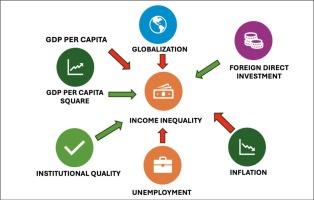全球化、外国直接投资和通货膨胀会导致收入不平等吗?来自索马里的库兹涅茨曲线假说的证据
Q1 Economics, Econometrics and Finance
引用次数: 0
摘要
了解索马里收入不平等的动态对于诊断阻碍包容性经济增长和发展的结构性障碍至关重要。认识到这些差异可以促成更有效的政策,促进公平和可持续的进步。因此,本研究利用Dickey-Fuller平稳性检验和ARDL方法对1990年至2020年索马里收入不平等的决定因素进行了探讨。边界检验方法验证了经济增长、全球化、外国直接投资(FDI)、制度质量、失业、通货膨胀和收入不平等之间的长期协整关系。研究结果表明,人均GDP最初会增加收入不平等,支持库兹涅茨曲线假设,但随着经济的成熟,这种影响会减弱。从长期和短期来看,全球化不断加剧收入不平等。相反,外国直接投资和机构质量仅在短期内与收入不平等的减少显著相关。在这两个时间段内,较高的失业率和通货膨胀显著加剧了索马里的收入不平等。KRLS的稳健性分析证实了ARDL结果的可靠性。此外,格兰杰因果检验揭示了人均GDP与收入不平等、全球化与收入不平等之间的双向因果关系。同时,FDI、制度质量、失业率和通货膨胀表现出单向影响。根据这些发现,该研究建议采用包容性增长框架,对教育和基础设施进行持续投资,进行战略性贸易和投资改革,实施综合就业计划,并实施审慎的货币政策,以缓解索马里的收入不平等。本文章由计算机程序翻译,如有差异,请以英文原文为准。

Do globalization, foreign direct investment, and inflation drive income inequality? Evidence from Somalia within the Kuznets curve hypothesis
Understanding the dynamics of income inequality in Somalia is essential for diagnosing the structural barriers that impede inclusive economic growth and development. Recognizing these disparities can lead to more effective policies that foster equitable and sustainable progress. Therefore, this study explores the determinants of income inequality in Somalia from 1990 to 2020, utilizing the Dickey-Fuller test for stationarity and the ARDL approach for analysis. The bounds-testing approach validated the long-run cointegration relationship between economic growth, globalization, foreign direct investment (FDI), institutional quality, unemployment, inflation, and income inequality. The findings indicate that GDP per capita initially increases income inequality, supporting the Kuznets curve hypothesis, but this effect diminishes as the economy matures. Globalization consistently exacerbates income inequality in the long- and short-run. Conversely, FDI and institutional quality are significantly linked to reductions in income inequality only in the short-run. Higher unemployment rates and inflation significantly increase income inequality in Somalia across both time frames. Robustness analysis via KRLS confirms the reliability of the ARDL outcomes. Furthermore, the Granger causality tests reveal bidirectional causality between GDP per capita and income inequality, as well as between globalization and income inequality. At the same time, FDI, institutional quality, unemployment, and inflation exhibit unidirectional influences. Drawing on these findings, the study suggests the adoption of inclusive growth frameworks, sustained investments in education and infrastructure, strategic trade and investment reforms, comprehensive employment programs, and prudent monetary policies to mitigate income inequality in Somalia.
求助全文
通过发布文献求助,成功后即可免费获取论文全文。
去求助
来源期刊

Research in Globalization
Economics, Econometrics and Finance-Economics, Econometrics and Finance (miscellaneous)
CiteScore
8.00
自引率
0.00%
发文量
31
审稿时长
79 days
 求助内容:
求助内容: 应助结果提醒方式:
应助结果提醒方式:


